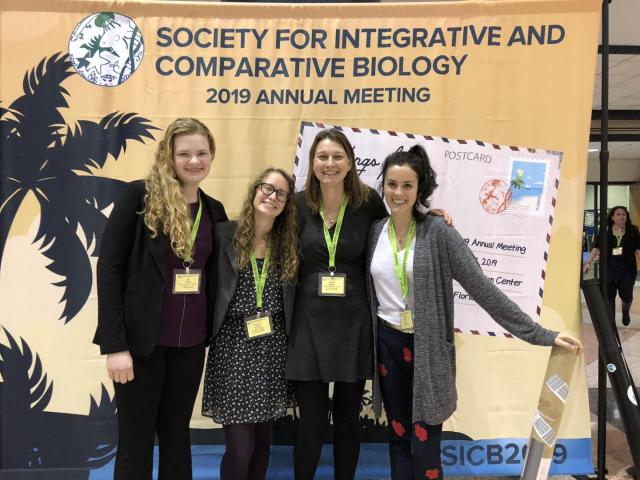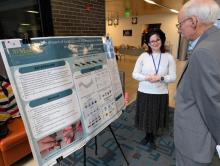
Assistant Professor of Biology Jessica Malisch and students from her lab presented their research at the Annual Meeting for the Society of Integrative and Comparative Biology (SICB) in Tampa, Florida, Jan. 3-7, 2019. The mission of SICB is to further research, educate and create public awareness in the areas of organismal, functional and evolutionary biology. Research in Malisch's lab focuses on the vertebrate stress response with an emphasis on hormones and metabolism in free-living sparrows.
Melanie Kimball '19 presented a poster about her St. Mary's Project:
Acute stress and glucose mobilization in Mountain Dark-eyed Juncos (Junco hyemalis) KIMBALL, MG*; CHRISLER, AD; GRANT, A; MALISCH, JL; St. Mary's College of Maryland; St. Mary's College of Maryland; Univ. of Nevada, Reno; St. Mary's College of Maryland
Resource mobilization and reallocation is a major endpoint of the physiological response to acute stress. In mammals, a hyperglycemic response to acute stress is well characterized, however, it is not consistently detectable in non-mammalian vertebrates. A hyperglycemic response to acute handling stress has been shown in some passerines including White-crowned Sparrows and White-throated Sparrows. Here we characterized the glycemic response to acute-handling stress in a breeding, free-living, population of Mountain Dark-eyed Juncos (Junco hyemalis) in Mono County, California. Juncos were trapped in seed-baited potter traps at Tioga Pass Meadow from May 17 to June 20, 2018, coinciding with territory establishment and early nesting period. Blood samples were collected at 0, 15 and 30 min post-capture. We utilized a human blood glucose meter, FreeStyle Lite, to determine real-time glucose levels in the field, after previously validating this novel technique. Consistent with research in other sparrow species listed above, blood glucose levels were higher than baseline (time point zero) at 15 minutes (42.6% increase) and 30 minutes post-capture (66.7% increase). Additionally, predictors of glucose mobilization including: date, scaled body mass, fat score, hematocrit, sex, and bleed delay time were modeled using backward and forward stepwise regression. Analysis showed that Juncos mobilize glucose in response to acute handling stress and response is best modeled when scaled mass, hematocrit, and date are included as predictor variables. These results suggest that glucose mobilization capacity is influenced by measures of body condition including mass and hematocrit, and the response may fluctuate during the breeding season.
Ava Chrisler '20 presented a poster about research she conducted over the summer of 2018 as a directed researcher on Malisch's Tioga Sparrow Research Project near Yosemite, California:
Predictors of glucocorticoid and glucose mobilization in response to an acute handling challenge in Mountain White-crowned Sparrows (Zonotrichia leucophrys oriantha) CHRISLER, AD*; GRANT, A; KIMBALL, MG; CAPASSO, DM; JOHNSON, EE; MALISCH, JL; St. Mary's College of Maryland; University of Nevada, Reno; St. Mary's College of Maryland; St. Mary's College of Maryland; St. Mary's College of Maryland
Acute challenges initiate a suite of physiological responses including activation of the sympathetic nervous system and hypothalamic-pituitary-adrenal axis. Collectively these responses promote energy mobilization and resource allocation to support survival. Here we characterized the glucocorticoid and hyperglycemic response to a standard acute handling stressor in a free-living population of Mountain White-crowned Sparrows and modeled potential predictors of the glucose and glucocorticoid response to challenge. Sparrows were trapped in seed-baited potter traps at Tioga Pass Meadow, California, during the early-mid breeding season (May-June 2018). Blood samples were collected at 0, 15 and 30 min post-capture. Blood glucose was quantified in the field using a FreeStyle Lite meter, and glucocorticoid levels were analyzed in the lab. Consistent with previous research in this population, blood glucose and glucocorticoid levels respond positively to challenge. Glucose increased 34% above baseline by 15 min and 54% 30 minutes post capture. Glucocorticoid levels increased 309% above baseline by 15 min and 500% by 30 min post-capture. Potential predictors of glucose and glucocorticoid mobilization were modeled using scaled body mass, fat score, hematocrit, sex, date and bleed delay time as variables. The most prominent predictor of both glucocorticoid and glucose mobilization was fat score. These results suggest that stored lipid-based resources influence the physiological response to stress. Future studies should examine additional energy substrates such as triglycerides and cholesterol to further tease apart the physiological response to challenge.
In addition, Malisch and members of her lab were coauthors on two additional research presentations:
Glucocorticoid physiology, territory size, and number of chicks fledged: Untangling the relationship between corticosterone and reproductive success GRANT, AR*; MALISCH, JL; KIMBALL, MG; OUYANG, JQ; University of Nevada, Reno; St. Mary's College of Maryland; St. Mary's College of Maryland; University of Nevada, Reno
Breeding is an energetically expensive life history stage, particularly for short-lived organisms inhabiting highly variable environments. Corticosterone (cort), a glucocorticoid hormone, is released in response to noxious and unpredictable stimuli but also acts to increase metabolism at baseline levels. Successful individuals need to balance energy expenditure and costs to maximize fitness. However, evidence for a clear relationship between cort and fitness is lacking, complicated by the fact that this relationship can change within and between life-history stages. We collected repeated within-individual baseline and stress-induced plasma and feather cort levels using free-living mountain white-crowned sparrows (Zonotrichia leucophrys oriantha) from pre-breeding to post-breeding during variable environments. Additionally, we mapped territory size for breeding pairs using telemetry and collected data on reproductive success. Using nest cameras during incubation through fledging, we also measured reproductive effort. We discuss the link between the cort phenotype, territory size, and reproduction. These repeated measures data add to the growing research on understanding how flexible cort phenotypes act in changing environments.
Acute Administration of Exogenous Corticosterone in Seabird Chicks Rapidly Mobilizes Lipids but not Glucose BENOWITZ-FREDERICKS, ZM*; CAINE, PB; MALISCH, JL; EDWARDS, KM; FARMER, JL; HAUSSMANN, MF; HATCH, SA; Bucknell Univ.; Bucknell Univ.; St. Mary's of Maryland; Bucknell Univ.; Bucknell Univ.; Bucknell Univ.; Inst. Seabird Research & Cons.
In developing birds, costs of elevated glucocorticoids have been repeatedly demonstrated while benefits – reallocation of endogenous resources - are often assumed. Although mobilization of glucose in response to elevated glucocorticoids occurs in mammals, some studies suggest that in birds, lipid rather than glucose mobilization may be the primary resource reallocation pathway. However, most of the evidence about relationships between glucocorticoids and glucose in birds is either conducted in captivity or correlational, based on concurrent increases in corticosterone (cort) and glucose during capture-and-handling protocols. We tested the hypothesis that in free-living birds, cort has a larger effect on the acute mobilization of lipid-based energy substrates than on glucose. We administered a single oral dose of cort in oil to black-legged kittiwake (Rissa tridactyla) chicks; total handling time averaged 20 sec. We collected blood 15, 30, or 60 min after cort administration and compared circulating glucose, triglycerides, and cholesterol in cort-treated chicks to those in oil-only controls and unhandled controls. At 30 min, both groups of handled chicks had elevated glucose compared to unhandled controls, but cort and oil treatments did not differ.. Triglycerides were not responsive to treatments, however, cholesterol was elevated in cort chicks 15 min after administration, suggesting non-genomic effects of corticosterone on cholesterol mobilization. Disentangling the roles of catecholamines and glucocorticoids will require additional experimental manipulations and attention to very short time scales.



